The Commissioner of the Pavilion
of Spain, Miguel Garcia de Saez.
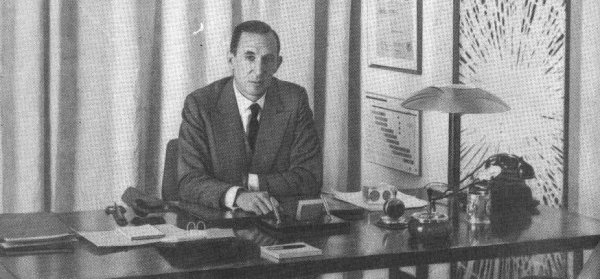 |
-
WELCOME TO THE
-
PAVILION OF SPAIN
- Now, as the New York World's
Fair enters upon its second year, the Pavilion of Spain welcomes
its guests gladly ... Now is the time to recall last year's experience
which, for us Spaniards, was a truly thrilling one. Ten million
people visited our Pavilion and it received the generous applause
of personalities well-known in the Untied States and throughout
the world.
-
- The real importance of this
experience, however, is not to be found in statistics. The motto
of this World Fair is Peace through Understanding. We
have done everything possible to bring you an image of Spain
that will help you to know us better and which will also help
to bring us closer, physically and spiritually, to men the world
over. By contemplating the paintings of our great artists and
the products of our industry and of our craftsmanship, by hearing
our songs and watching our dances, and by drinking our wine,
you have become friends of the real Spain, gay and hardworking,
sunny, following the path of her history with faith and optimism.
-
- We hope that the new contributions
offered by the Pavilion of Spain in this second phase of the
World Fair will go even further towards strengthening the ties
of friendship already created. World peace is sustained by the
cordial everyday gestures of men of goodwill and the time will
come when the most distant peoples will know each other as good
neighbours do, thus affirming their will to live in freedom and
happiness. This has been and is the propose of the World Fair
and this is what we wish the purpose of our Pavilion to be. We
must not forget, also, that the continent of America has an especially
profound and sincere dimension for Spaniards; that of being,
in its origins, the greatest historical achievement of our people.
-
- ... I would venture to say that
the greatest merit of the World Fair is that, as is the case
with the cinema (a form of artistic expression so well adjusted
to American psychology), it is possible to obtain a direct idea
of the participating countries. The ambition of those responsible
for the Pavilion of Spain has been to place their country before
the eyes of visitors, giving them a chance to come into contact
with a country of ancient tradition, today in the process of
renewing herself and which is always ready to offer a generous
welcome to all who approach her with goodwill.
-
-
MIGUEL GARCIA
DE SAEZ
-
Commissioner
of the Pavilion of Spain
|
-
THE PAVILION OF SPAIN
- Here is ... the Pavilion of
Spain. It is a gay and sincere sample full of hope and trust
of Spanish life in its most genuine manifestations. From the
primitive Romanesque art to the eternal Picasso, from the ancient
Iberian dances to the most recent industrial product, from the
arts of the people to the swagger women's fashions, Spain is
here.
-
- For the second time in a year
these doors open before you. observe the things of Spain with
kindness and follow the new routes of Spanish creation. It is
a true image of Spain that comes out to welcome you.
-
- One has to wander or walk through
the Pavilion of Spain, depending on the hurry or leisure of the
visitor, in order to enjoy it. There are no voice-recorders in
the Pavilion to explain everything in an impersonal voice; the
Spanish girls who are the guides are there to answer the visitor's
questions and this direct and human communication, though at
times possible less precise, makes the visitor feel more alive.
-
- The Pavilion of Spain is exceptional
from every point of view, including both the building and what
is exhibited inside it. The exterior aspect is unadorned, almost
harsh, a play of contrasting masses with rough, white, closed-in
walls forming the lower part and well disposed grey blocks in
the upper part. It is a sharp contrast between popular anonymous
architecture and the strength of the masses of the cultured architecture
which reached its finest flowering in the Monastery of the Escorial.
-
- The courtyards, full of plants
and flowers, onto which open the various rooms of the Pavilion,
full of murmuring shade, form a series of surprises in space,
offering solace and sweet dreams to the spirit.
-
- The most exacting present day
architectural ideas are blended with the truest of Spanish traditions.
All the ceilings of the Pavilion are lined with a modernized
version of carved wood paneling. The warm color of the walnut
above, harmonizes with the same tones of the clay tiles below.
Between these two belts of the same color, earth and tree, clay
and wood, the visitors to the Pavilion of Spain go to and fro.
In the show-cases, discreetly illuminated by aluminum lamps which
continue the same scheme as the caissons in the paneling, the
goods on show, no matter how insignificant they may be, glitter
like jewels ... The works of art which were specially created
for the Pavilion of Spain ... [are suited] to the high standard
that the architect, Sr. Carvajal has given to the Pavilion.
-
- The Pavilion of Spain is a surprise
and has been a surprise throughout the whole range of quality.
For some considerable time Spain was considered a gay and picturesque
land, very badly prepared to undertake serious enterprises; this,
by no means exact, opinion has probably been spread abroad by
Spaniards themselves. This opinion has met its death in the opening
to the curiosity of the world of the New York Fair. The Pavilion
of Spain has surprised everybody because of its beauty, because
of the various settings, because of the artistic treasures shown
in it, because of the high quality of everything that forms the
Pavilion from the cooks to the dancers and from the charming
hostesses who act as guides to the painters. The smallest detail
has been carefully seen to and studied with love and not only
interest. For the design of the glass, cutlery and table-services,
the best was chosen from among what was considered the smartest
and most seemly. There is one thing beyond doubt: the whole Pavilion
of Spain is a sum of qualities such as has rarely been brought
together in our country. It is a complete work, full of dignity,
which goes to prove the saying of Hegel: the innate superior
reality of the spirit.
|
-
THE NEW PAVILION OF SPAIN
-
IN ARTICLES
-
AND COMMENTARIES
- To think
that the Pavilion of Spain has to be dismantled, is to think
of one more assault against culture.
-
- Robert Sylvester, Daily News.
- April 27, 1965.
|
The Pavilion, in the International
zone.
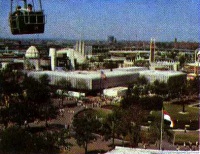 |
|
Main Courtyard
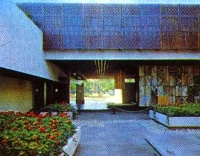 |
|
- The Spanish
Pavilion was so crowded at 1:30 p.m. that a visitor described
it as "like being in Times Square on Election Night in the
good old days."
-
- Robert Alden, The New York
Times.
- May 31, 1965.
|
- The Spanish
Pavilion is probably the best at the Fair. The exhibit of paintings
is different form last year's, and includes two large El Grecos,
two new Goyas, and a vast paining by Dali called "The Apotheosis
of the Dollar." The Marisqueria Restaurant is less expensive
and less formal than the other Spanish Restaurants, and is a
particularly pleasant place to cat on a sunny day...
-
- The New Yorker.
- May 29, 1965.
|
Granada Lobby
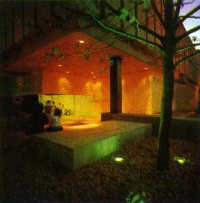 |
|
The Museum. The Maja of Goya (Prado
Museum)
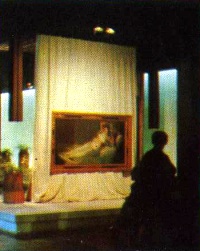 |
|
- The Pavilion
of Spain tossed the best ! World's Fair of 1965. And it's a safe
bet that no other pavilion will match the fiesta with the Spanish
open the 1965 second season.
-
- Frank Farrell, New York World
Telegram and Sun.
- April 22, 1965.
|
- I have never
seen a more dramatic effect in an art museum.
-
- Robert Wagner, Mayor
of New York.
- May, 1965.
|
Show Cases
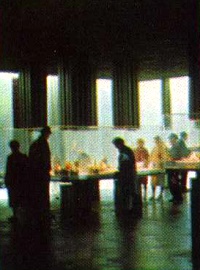 |
|
The Taberna Madrid shell-fish
tavern.
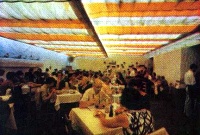 |
|
- It is the
most marvelous Pavilion I have ever seen in any of the many international
fairs I have visited in all my life. I most cordially congratulate
Spain on this success.
-
- Franz Korinek, Finance
Minister of Austria.
- May, 1965.
|
- I feel proud
of having been able to get to know personally the Pavilion everyone
in the United States is talking about.
-
- Jack M. Campbell, Governor
of the State of New Mexico.
- May 12, 1965.
|
Sculpture of Friar Junipero Serra.
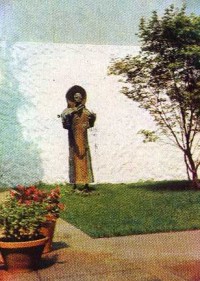 |
|
The Feast of St. Anthony. The Churreria.
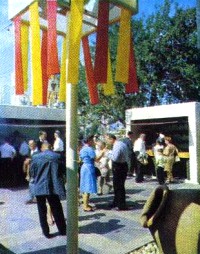 |
|
- Second time
around, the Spanish Pavilion at the World's Fair is the best
total work of art in the whole place. And to clinch matters,
the pavilion's painting and sculpture exhibitions are even better
than last year's.
-
- John Canaday, New York Times.
- May 3, 1965.
|
- The most
impressive exhibition of art, this year as last, is the Spanish
Pavilion.
-
- Emily Genauer, Herald Tribuine-Sunday
Herald Tribune Magazine.
- May 2, 1965.
|
Unveiling the statue of Hernando
de Soto.
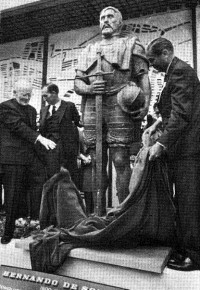 |
|
|
|
- Source: 1965 Guide
- Pavilion of Spain

|
|